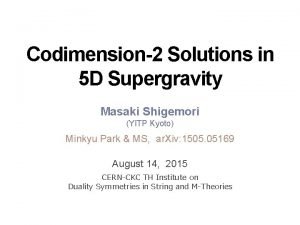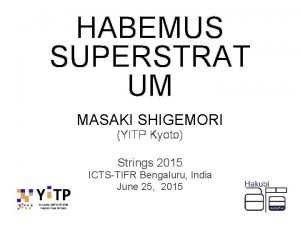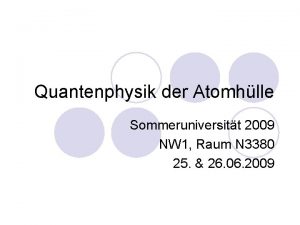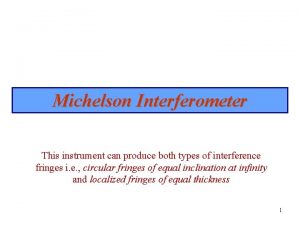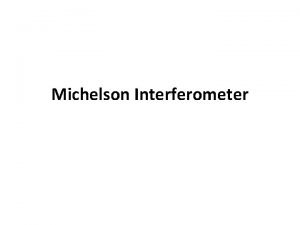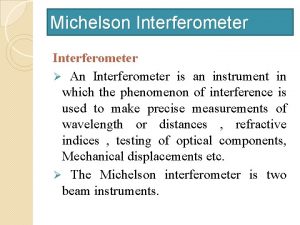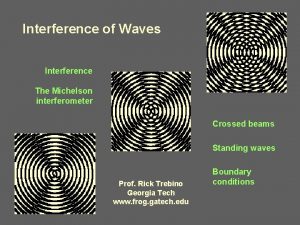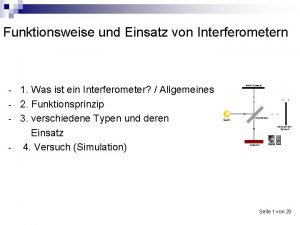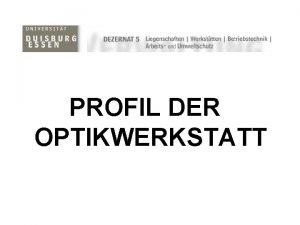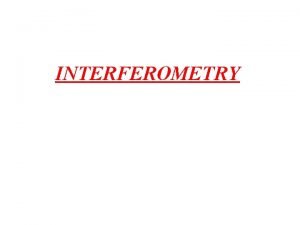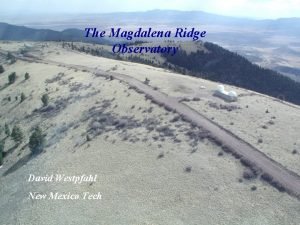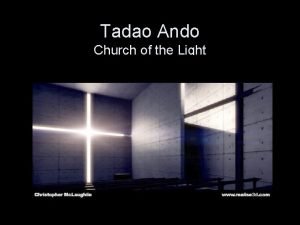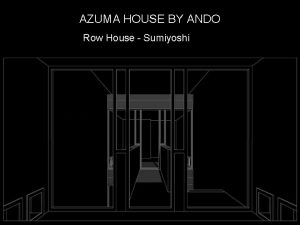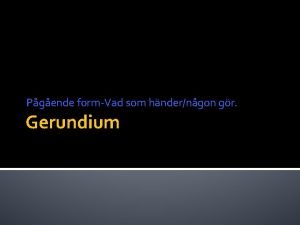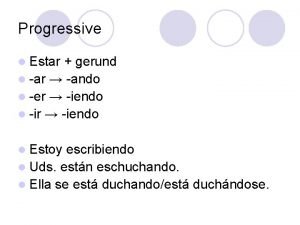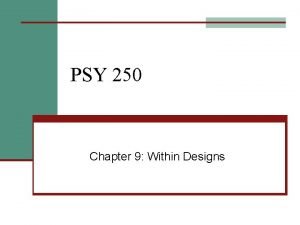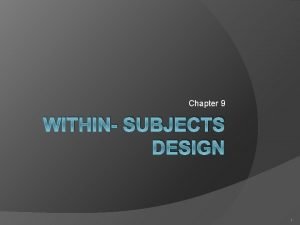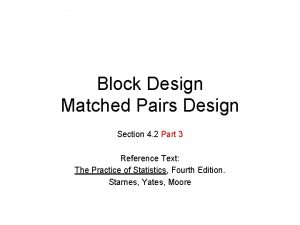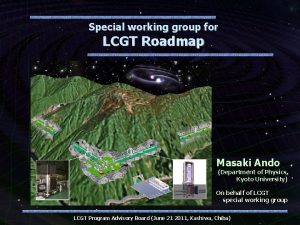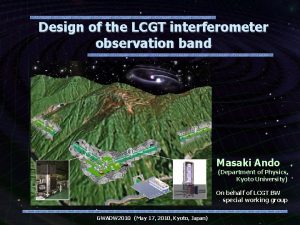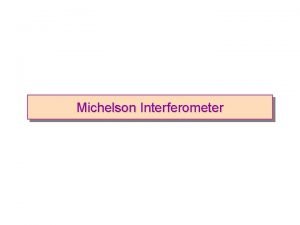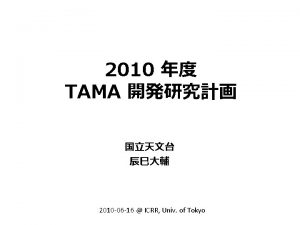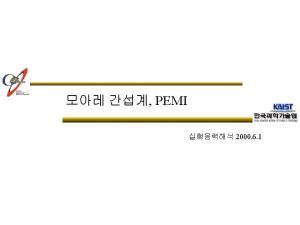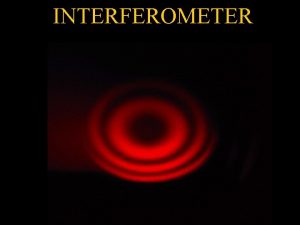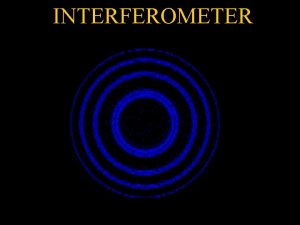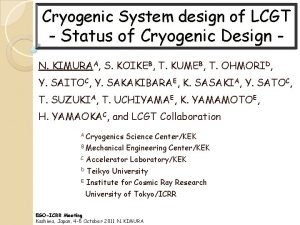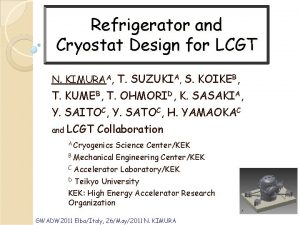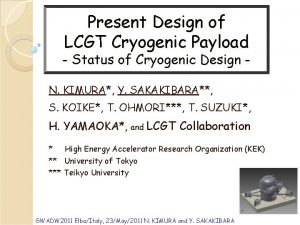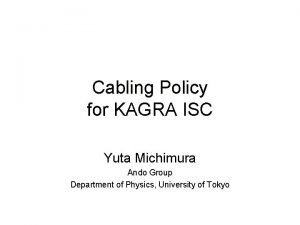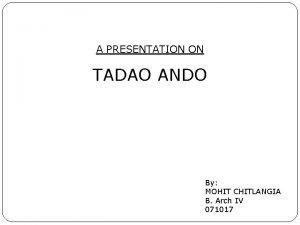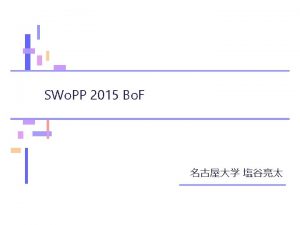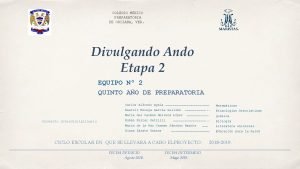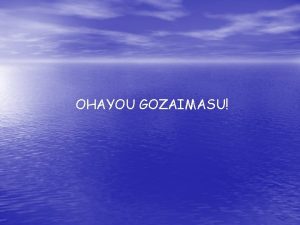Interferometer design of LCGT Masaki Ando Department of
































- Slides: 32

Interferometer design of LCGT Masaki Ando Department of Physics, University of Tokyo the LCGT collaboration LCGT Technical Advisory Committe (August 23, 2005, ICRR, Tokyo)

Outline 1. LCGT interferometer overview 2. LCGT optical layout 3. Main interferometer design 4. Input and output optics 5. Observation system 6. Summary LCGT Technical Advisory Committe (August 23, 2005, ICRR, Tokyo) 2

Interferometer overview LCGT Technical Advisory Committe (August 23, 2005, ICRR, Tokyo) 3

Overview (1) Interferometer overview Input optics Two nearby interferometers As independent as possible Center rooms: separated 3 km vacuum tube: common Main interferometer Broad band RSE with power recycling Arm cavity Finesse : 1550 Power Recycling Gain : 11 Signal band Gain : 15 Stored Power : 771 k. W Signal band : 230 Hz Two mode cleaners Baseline lengths : 10 m and 180 m Modulators for IFO control Laser stabilization Output optics Output mode cleaner Round trip length : 70 mm Multiple In. Ga. As photo diodes Observation system Monitor and organize the whole detector system Automatic lock-acquisition Automatic interferometer adjustment Monitor and diagnosis LCGT Technical Advisory Committe (August 23, 2005, ICRR, Tokyo) 4

Overview (2) LCGT interferometer Main IFO : 3 km IFO Input optics : Two MCs, Modulators, MMT Output optics: OMC, Photo detectors LCGT Technical Advisory Committe (August 23, 2005, ICRR, Tokyo) 5

Interferometer layout LCGT Technical Advisory Committe (August 23, 2005, ICRR, Tokyo) 6

Interferometer layout (1) 3 km arm Layout of two interferometers Center room for IFO-1 Center room for IFO-2 3 km arm LCGT Technical Advisory Committe (August 23, 2005, ICRR, Tokyo) 7

Interferometer layout (2) Optical layout of two interferometers Two interferometers are placed in separated center rooms make them as independent as possible 3 km vacuum tubes are used commonly by two IFOs Combined at steering tanks Vacuum tube diameter: 1000 mm Beam separation: 600 mm Each main mirror is placed in an independent vacuum tanks Mirrors are separated ~30 m Should be careful on Cross-coupling between interferometers Scattered-light from vacuum tube LCGT Technical Advisory Committe (August 23, 2005, ICRR, Tokyo) 8

Interferometer layout (3) Cross-coupling estimation Case 1 Refraction. Scattering Refraction D Scatter Case 2 Scattering D Scattered-light noise 1 ppm scattering Cross-coupling < 10 -10 Scattered-light noise: Scattered-light on mirror surface reflected by inner surface of the vacuum tube Vacuum tube is shaken by seismic motion Re-enter to the main beam by scattering Reduced by baffles in the vacuum tube Vacuum tube Two-reflection case Mirror Baffle LCGT Technical Advisory Committe (August 23, 2005, ICRR, Tokyo) One-reflection case 9

Interferometer layout (3) Baffle for LCGT Specification of LCGT Tube diameter 1000 mm Mirror diameter 250 mm Mirror distance 600 mm Mirror offset 340 mm Seismic motion 1 x 10 -11 m/Hz 1/2 @30 Hz Estimated scattered light noise 4. 2 x 10 -21 m/Hz 1/2 @30 Hz (Safety factor=7) (for one mirror) Baffle design Number: 45 x 2 for one arm Height: 35~50 mm Integration Surface: DLC coatings Diamond-Like Carbon (DLC) coatings Each reflection Surface roughness: Ra=20 nm Outgassing: lower than SS 316 with baking Reflectivity: 5% for p-polarization at 45 deg. 1/10 45 LCGT Technical Advisory Committe (August 23, 2005, ICRR, Tokyo) 10

Main interferometer LCGT Technical Advisory Committe (August 23, 2005, ICRR, Tokyo) 11

Main interferometer (1) Optical readout noise LCGT sensitivity : Mostly limited by quantum noises (Radiation pressure noise and Shot noise) Shot noise Phase fluctuation of light Proportional to P -1/2 Radiation pressure noise Amplitude fluctuation of light Proportional to P 1/2 Noise level depends on Laser power in IFO Signal band of IFO Design the interferometer optical parameters LCGT Technical Advisory Committe (August 23, 2005, ICRR, Tokyo) 12

Main interferometer (2) Interferometer optical configuration Ideally, possible to realize same power and signal BW with any config. Large power on BS Power : cavity finesse, PRM Signal BW : cavity finesse, SRM Realistic constraint Loss in optics and interference Simplicity of control system Thermal problem in optics LCGT Technical Advisory Committe (August 23, 2005, ICRR, Tokyo) Large Finesse of cavities 13

Main interferometer (3) LCGT optical configuration Resonant-sideband extraction with power recycling o er End mirror y it av tc Resonant-sideband extraction SEM+FM Decrease effective finesse for signals Increase signal band by Signal-band gain (SBG) P y- br End mirror Power recycling PRM+FM Increase effective finesse Increase power in cavities by Power-recycling gain (PRG) Finesse x 2/p = Light bounce number in a FP cavity Fa High-finesse arm cavities PRM between BS and laser source SEM at the detection port Front mirror r Fab rot e y-P ty i cav Beam splitter Power recycling mirror Signal-extraction mirror Photo detector LCGT Technical Advisory Committe (August 23, 2005, ICRR, Tokyo) 14

Main interferometer (4) Merit of RSE High-finesse cavity and moderate PRG Easier to realize high power in cavities Smaller transmission light in optics Main reason for LCGT Flexible optimization for GW sources Independent adjustment of power in cavities and signal band Narrow-band observation (optional) Absorption in sapphire substrates Heat absorption : 20 ppm/cm x 15 cm = 300 ppm Cooling power : 1 W for each mirror Laser power on BS should be less than ~1 k. W (safety factor 3) LCGT Technical Advisory Committe (August 23, 2005, ICRR, Tokyo) 15

Main interferometer (5) Optical parameter selection Optimize for 1. 4 Msolar NS inspiral Realistic parameters Observable range [Mpc] Calculate observable range as a function of Light power in cavities Signal bandwidth Arm cavity Finesse : 1550 Power Recycling Gain : 11 Signal Band Gain : 15 Stored Power : 771 k. W Signal band : 230 Hz Observable range : 185 Mpc SNR = 10 Single interferometer Optimal direction and polarization LCGT Technical Advisory Committe (August 23, 2005, ICRR, Tokyo) 16

Interferometer control (1) Interferometer length control 5 degrees of freedom to be controlled Common arm length: Differential arm length: PRC length: Michelson length: SEC length: L+ = L 1 + L 2 L+ = L 1 - L 2 l P= l 1 + l 2 l- = l 1 + l 2 ls = l 1 + l 2 Signal extraction Two modulations on the input light Phase modulation Amplitude modulation Demodulate the output of photo-detectors at three signal port (Dark, Bright, Pick-off) Independent signals L+ L- lp l- ls VB 1 0 -4 x 10 -3 0 3 x 10 -3 VD 0 1 x 10 -3 0 VP 2 x 10 -3 0 1 0 0. 7 VD 0 1 x 10 -3 0 1 0 VD -3 x 10 -4 0 -1. 3 0 1 LCGT Technical Advisory Committe (August 23, 2005, ICRR, Tokyo) 17

Interferometer control (2) Interferometer length control (contd. ) Signal feedback Common arm length: Differential arm length: PRC length: Michelson length: SEC length: L+ Input optics, mirrors (~0. 1 Hz) L- Mirrors (~1 k. Hz) l P PRM (~1 k. Hz) l - BS (~10 Hz) l s SEM (~1 k. Hz) LCGT Technical Advisory Committe (August 23, 2005, ICRR, Tokyo) 18

Interferometer control (3) Lock acquisition Linear error signals are obtained only around the operational point of IFO How to acquire the operational condition at first ‘Lock acquisition’ problem Experimental results - successful lock acquisition and operation High finesse cavity: 20 m prototype interferometer at Kamioka Finesse : 25, 000 comparable light-storage time with LCGT Power recycling on FPMI: Prototype IFOs (3 m at UT, 20 m at NAO, 40 m at Caltech) Current interferometric detectors (LIGO, VIRGO, TAMA) >10 PRG has been realized RSE (or signal recycling): Prototype IFOs (4 m at NAO, 10 m at Glasgow, 40 m at Caltech) LCGT environment Kamioka site : very small seismic vibration (10 -2 -10 -3 of the TAMA site) Low-frequency vibration isolation system (SAS) Suspension-point interferometer LCGT Technical Advisory Committe (August 23, 2005, ICRR, Tokyo) 19

Input and output optics LCGT Technical Advisory Committe (August 23, 2005, ICRR, Tokyo) 20

Input and output optics (1) Input optics 1 st MC Baseline length : 10 m Finesse : 1700 Reject RF noises 2 nd MC Baseline length : 180 m Finesse: 1000 Reject wavefront distortions caused by modulators, etc. Reject beam jitters Transmits RF sidebands used for IFO control Modulators Mach-Zehnder interferometer for phase and amplitude modulation Mode-matching telescopes (MMT) Change mode-profile to match IFOs Reflective-type to avoid scattered light LCGT Technical Advisory Committe (August 23, 2005, ICRR, Tokyo) 21

Input and output optics (2) Frequency stabilization Stability requirement 10 -8 Hz/Hz 1/2 at 6 Hz (Safety factor: 10, CMRR: 100) Multi-stage stabilization L+ signal 2 nd MC 1 st MC Laser source LCGT Technical Advisory Committe (August 23, 2005, ICRR, Tokyo) 22

Input and output optics (3) Output optics Output Mode Cleaner (OMC) Reject junk light before photo detector Suppression ratio : >16 d. B Short fixed-mirror cavity Round-trip length : 70 mm Finesse 14 Transmits both carrier and RF sidebands Stability requirement 15 Hz/Hz 1/2 at 100 Hz will be possible to achieve with vibration isolation in a vacuum tank Photo detector Receive a few watt power Have high quantum efficiency High response speed to detect RF signals Use multiple (4 -32) In. Ga. As photo diodes LCGT Technical Advisory Committe (August 23, 2005, ICRR, Tokyo) 23

Observation system LCGT Technical Advisory Committe (August 23, 2005, ICRR, Tokyo) 24

Observation system (1) Observation system Monitor the detector condition Keep high duty cycle operation and best sensitivity of the detector Automatic lock-acquisition Automatic interferometer adjustment Monitor and diagnosis Master-system (intelligent switching) Supervise whole detector system Self-switching sub-system Stand-alone control of subsystem Laser system, MC system, Seismic isolation system, etc. Control circuits Switched and adjusted by master system LCGT Technical Advisory Committe (August 23, 2005, ICRR, Tokyo) 25

Observation system (2) Automatic operation in TAMA-DT 9 Master-system (intelligent switching) PC + PCI boards + Lab. VIEW 64 ch digital I/O 16 ch A/D + 24 ch D/A Lock acquisition Auto adjustment Interface with external system Self-switching sub-system Logic circuit + Embedded micro processor Laser source control MC control Laser intensity stabilization Beam axes control Crewless operation 3 times of continuous operations longer than 24 h LCGT Technical Advisory Committe (August 23, 2005, ICRR, Tokyo) 26

Summary LCGT Technical Advisory Committe (August 23, 2005, ICRR, Tokyo) 27

Summary Interferometer conceptual design Input optics Two nearby interferometers As independent as possible Center rooms: separated 3 km vacuum tube: common Main interferometer Broad band RSE with power recycling Arm cavity Finesse : 1550 Power Recycling Gain : 11 Signal Band Gain : 15 Stored Power : 771 k. W Signal band : 230 Hz Two mode cleaners Baseline lengths : 10 m and 180 m Modulators for IFO control Laser stabilization Output optics Output mode cleaner Round trip length : 70 mm Multiple In. Ga. As photo diodes Observation system Monitor and organize the whole detector system Automatic lock-acquisition Automatic interferometer adjustment Monitor and diagnosis LCGT Technical Advisory Committe (August 23, 2005, ICRR, Tokyo) 28

End LCGT Technical Advisory Committe (August 23, 2005, ICRR, Tokyo) 29

Comparison of detectors Comparison of next generation GW detectors LCGT (JPN) 2 detectors (3 km) (2 nearby detectors) Long baseline Better seismic attenuation system Underground site Low-mechanical-loss mirrors and suspensions Cryogenic (20 k) High-power laser source Low-loss optics Broad-band RSE config. Advanced LIGO (USA) Scale Seismic noise reduction Thermal noise reduction Quantum noise reduction 3 detectors (4 km) (2 nearby, 1 separated) Long baseline Better seismic attenuation system Suburban site Low-mechanical-loss mirrors and suspensions Flat-top beam High-power laser source Low-loss optics Detuned RSE config. LCGT Technical Advisory Committe (August 23, 2005, ICRR, Tokyo) 30

Main parameters Detector parameters Laser Nd: YAG laser (1064 nm) Injection lock + MOPA Power : 150 W Main Interferometer Broad band RSE configuration Baseline length : 3 km Beam Radius : 3 -5 cm Arm cavity Finesse : 1550 Power Recycling Gain : 11 Signal Band Gain : 15 Stored Power : 771 k. W Signal band : 230 Hz Vacuum system Beam duct diameter : 100 cm Pressure : 10 -9 Torr Mirror Sapphire substrate + mirror coating Diameter : 25 cm Thickness : 15 cm Mass : 30 kg Absorption Loss : 20 ppm/cm Temperature : 20 K Q = 108 Loss of coating : 10 -4 Final Suspension + heat link with 4 Sapphire fibers Suspension length : 40 cm Fiber diameter : 1. 5 mm Temperature : 16 K Q of final suspension : 108 LCGT Technical Advisory Committe (August 23, 2005, ICRR, Tokyo) 31

Broadband vs Narrowband Detuned interferometer case Detuned RSE configuration SNR increase 23% Event rate increase 86% LCGT Technical Advisory Committe (August 23, 2005, ICRR, Tokyo) 32
 Bunkasha games
Bunkasha games Masaki shigemori
Masaki shigemori Nene masaki
Nene masaki Masaki shigemori
Masaki shigemori Mach zehnder interferometer leifi
Mach zehnder interferometer leifi Types of fringes in michelson interferometer
Types of fringes in michelson interferometer Prinsip kerja interferometer adalah
Prinsip kerja interferometer adalah What is the principle of michelson interferometer
What is the principle of michelson interferometer Constructive vs destructive interference
Constructive vs destructive interference Weißlichinterferometer funktionsweise
Weißlichinterferometer funktionsweise Interferometer oberflächenmessung
Interferometer oberflächenmessung Laser interferometer space antenna
Laser interferometer space antenna Pitter npl gauge interferometer
Pitter npl gauge interferometer Magdalena ridge observatory
Magdalena ridge observatory Tadao ando churches
Tadao ando churches Azuma house
Azuma house Tadao ando osaka
Tadao ando osaka Estoy böjning
Estoy böjning Progressive tense spanish
Progressive tense spanish Estar gerund
Estar gerund Ando leppiman
Ando leppiman Visual communication design study design
Visual communication design study design Design input output
Design input output What is this
What is this Decorative design types
Decorative design types Within participants design
Within participants design Split range
Split range Within subject design vs between subject design
Within subject design vs between subject design Within participants design
Within participants design Matched pairs design diagram
Matched pairs design diagram User interface design in system analysis and design
User interface design in system analysis and design Block design vs matched pairs
Block design vs matched pairs Elements and principles of design ppt
Elements and principles of design ppt

